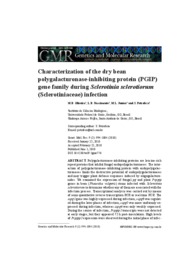Characterization of the dry bean polygalacturonase-inhibiting protein (PGIP) gene family during Sclerotinia sclerotiorum (Sclerotiniaceae) infection.
Characterization of the dry bean polygalacturonase-inhibiting protein (PGIP) gene family during Sclerotinia sclerotiorum (Sclerotiniaceae) infection.
Author(s): OLIVEIRA, M. B.; NASCIMENTO, L. B.; JUNIOR, M. L.; PETROFEZA, S.
Summary: Polygalacturonase-inhibiting proteins are leucine-rich repeat proteins that inhibit fungal endopolygalacturonases. The interaction of polygalacturonase-inhibiting protein with endopolygalacturonases limits the destructive potential of endopolygalacturonases and may trigger plant defense responses induced by oligogalacturonides. We examined the expression of fungal pg and plant Pvpgip genes in bean (Phaseolus vulgaris) stems infected with Sclerotinia sclerotiorum to determine whether any of them are associated with the infection process. Transcriptional analysis was carried out by means of semi-quantitative reverse transcription PCR or real-time PCR. The sspg1 gene was highly expressed during infection; sspg3 was regulated during the later phases of infection; sspg5 was more uniformly expressed during infection, whereas sspg6 was only weakly expressed. During the course of infection, Pvpgip1 transcripts were not detected at early stages, but they appeared 72 h post-inoculation. High levels of Pvpgip2 expression were observed during the initial phase of infection; the transcript peaked by 48 h post-inoculation and declined by 72 h post-inoculation. Pvpgip3 expression increased strongly at 96 h post-inoculation. Pvpgip4 was constantly present from 24 h post-inoculation until the end of the experiment. However, we detected higher levels of the Pvpgip4 transcript in the necrotic lesion area than in plants that had been mechanically wounded. Remarkably, only Pvpgip4 appeared to be moderately induced by mechanical wounding. These results provide evidence that endopolygalacturonases contribute to the infection process during host colonization by promoting the release of plant cell oligogalacturonides, which are powerful signaling molecules and may also activate plant defenses, such as polygalacturonase-inhibiting proteins.
Publication year: 2010
Types of publication: Journal article
Unit: Embrapa Rice & Beans
Observation
Some of Embrapa's publications are published as ePub files. To read them, use or download one of the following free software options to your computer or mobile device. Android: Google Play Books; IOS: iBooks; Windows and Linux: Calibre.
Access other publications
Access the Agricultural Research Database (BDPA) to consult Embrapa's full library collection and records.
Visit Embrapa Bookstore to purchase books and other publications sold by Embrapa.

